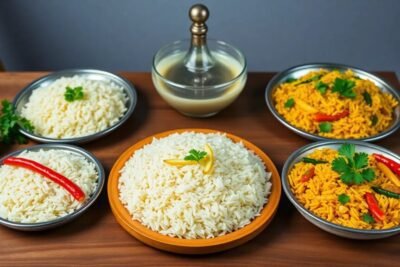
Delicious Diabetic-Friendly Korean Recipes to Satisfy Your Cravings
- Introduction to Diabetic-Friendly Korean Cuisine
- Understanding the Basics of Diabetes and Nutrition
- Essential Ingredients for Diabetic-Friendly Korean Cooking
- Top 5 Diabetic-Friendly Korean Recipes
- Cooking Techniques to Embrace
- Balancing Korean Flavors with Healthy Choices
- Creating Meal Plans with Korean Dishes
- Frequently Asked Questions about Korean Cuisine and Diabetes
- Conclusion: Embracing a Healthier Lifestyle with Korean Cuisine
Introduction to Diabetic-Friendly Korean Cuisine
Korean cuisine is renowned for its rich flavors, colorful presentations, and variety of textures. The cuisine features a diverse array of ingredients, from fresh vegetables to fermented foods like kimchi, which not only contribute to the dishes' taste but also offer health benefits. However, for individuals managing diabetes, the challenge lies in adapting these traditional recipes to ensure they remain both delicious and diabetic-friendly. Understanding the balance between flavor and nutrition is essential in making Korean dishes suitable for those requiring dietary modifications.
At the heart of diabetic-friendly Korean recipes is the careful selection of ingredients. Utilizing whole grains, such as brown rice or barley, instead of highly processed options can significantly lower glycemic impact. Additionally, incorporating a variety of non-starchy vegetables can enhance the nutritional profile while minimizing the overall carbohydrate content. Lean proteins, like chicken, tofu, and fish, are favored in making these recipes heart-healthy and satisfying.
Flavor enhancement in diabetic-friendly Korean cuisine can also be achieved through creative use of herbs and spices. Ingredients like garlic, ginger, and sesame oil add depth without adding excess sugar or unhealthy fats. For example, using a light homemade gochujang (Korean chili paste) can provide that signature spicy kick while allowing for portion control in terms of sugar intake. Furthermore, the method of cooking plays a significant role; steaming, grilling, or stir-frying with minimal oil can contribute to making traditional meals heart-healthy and manageable for blood sugar levels.
This flexible approach allows for the successful adaptation of iconic dishes, making them inclusive for individuals seeking to enjoy the flavors of Korean cuisine without compromising their health. By embracing these practices, anyone can savor savory, diabetic-friendly Korean recipes that cater to diverse palates while supporting dietary needs.
Understanding the Basics of Diabetes and Nutrition
Diabetes is a chronic condition characterized by elevated levels of glucose in the blood, resulting from either insufficient insulin production or the body's inability to effectively utilize insulin. Managing diabetes effectively hinges on understanding how nutrition impacts blood glucose levels, making dietary choices crucial for individuals living with this condition. One key concept in this regard is the glycemic index (GI), which ranks carbohydrate-containing foods based on their blood glucose response. Foods with a low GI are digested and absorbed more slowly, leading to gradual increases in blood sugar levels, making them an essential component of diabetic friendly Korean recipes.
Additionally, carbohydrate counting is a valuable tool that aids in managing diabetes by allowing individuals to track their carbohydrate intake throughout the day. This practice helps in balancing meals to maintain stable blood sugar levels. For those interested in incorporating diabetic friendly Korean recipes into their meals, understanding the carbohydrate content of traditional ingredients is vital. Ingredients such as brown rice, tofu, and various non-starchy vegetables can be excellent alternatives that align with a healthy eating pattern. By being mindful of portion sizes and combinations, individuals can create balanced meals that fulfill their cravings while helping to manage their condition.
Balanced meals are another cornerstone of diabetic management, combining carbohydrates with proteins and healthy fats to create a sustainable meal structure. This not only helps in controlling blood sugar spikes but also promotes satiety and overall health. Implementing these principles within the context of Korean cuisine opens a variety of possibilities. By focusing on minimally processed ingredients and mindful cooking techniques, such as steaming, grilling, and fermenting, diabetic friendly Korean recipes can be both flavorful and nutritious. Engaging with these dietary concepts ensures that individuals can enjoy their favorite dishes without compromising their health.
Essential Ingredients for Diabetic-Friendly Korean Cooking
When creating diabetic-friendly Korean recipes, the choice of ingredients plays a pivotal role in ensuring that meals are both flavorful and healthy. Incorporating the right components can transform traditional dishes into suitable options that align with a balanced diet. Here are some essential ingredients commonly used in diabetic-compatible Korean recipes.
First and foremost, low-carb vegetables serve as the backbone of many Korean dishes. Examples include napa cabbage, zucchini, Korean radish (mu), and various leafy greens such as perilla or spinach. These vegetables are rich in fiber and nutrients while being low in carbohydrates, making them excellent choices for maintaining stable blood sugar levels. Additionally, they can be used in a variety of preparations, whether in stews, stir-fries, or side dishes.
Lean proteins are another critical component for diabetic-friendly Korean cooking. Foods like skinless chicken, tofu, and fish are particularly beneficial. These proteins can help to balance meals and keep you feeling satisfied without increasing carbohydrate intake. Incorporating seafood, which is a staple in Korean cuisine, can also provide omega-3 fatty acids, valuable for overall health.
Alternative seasoning strategies are crucial when crafting meals suited for diabetic diets. Often, traditional Korean recipes rely heavily on sauces and sugary marinades that can spike blood sugar levels. Instead, consider using natural flavor enhancers like garlic, ginger, sesame oil, and low-sodium soy sauce. These ingredients can add depth and richness to your dishes without the need for excess sugar or unhealthy fats.
For those seeking these ingredients, local Asian markets often carry a wide selection of the vegetables and seasonings mentioned above. Grocery chains increasingly offer specialty ethnic aisles where these can be found, ensuring easy access. By prioritizing these essential components, preparing diabetic-friendly Korean recipes at home becomes a manageable and enjoyable endeavor.
Top 5 Diabetic-Friendly Korean Recipes
Korean cuisine offers a vibrant array of flavors and ingredients that can be adapted for those managing diabetes. Here are five diabetic-friendly Korean recipes that not only address dietary needs but also provide delicious culinary satisfaction.
1. Spicy Tofu Stew (Sundubu Jjigae)
This dish is both hearty and nutritious, featuring silken tofu, vegetables, and a slightly spicy broth. To prepare, sauté garlic and onions, add gochugaru (Korean red pepper flakes), and toss in your choice of low-carb vegetables like zucchini or mushrooms. Add vegetable broth and bring to a simmer before adding the tofu. Serve hot with a sprinkle of sesame oil. This stew is high in protein and fiber, keeping blood sugar levels stable.
2. Kimchi Fried Cauliflower Rice
A twist on traditional fried rice, this recipe uses cauliflower rice, making it low-carb and high in nutrients. Sauté garlic, onion, and kimchi in sesame oil, then add cauliflower rice and stir-fry until tender. Finish with a splash of low-sodium soy sauce for flavor. Packed with probiotics from kimchi, this dish supports gut health while offering a satisfying meal.
3. Grilled Miso Salmon
Rich in omega-3 fatty acids, salmon is an excellent protein choice for diabetics. Marinate salmon fillets in a mixture of miso paste, mirin, and a sugar substitute for added flavor. Grill the fillets until cooked through. Serve with steamed broccoli and asparagus for a complete meal that is satisfying and balanced.
4. Korean BBQ Chicken Lettuce Wraps
These wraps are perfect for a light dinner. Use skinless chicken breast marinated in a mixture of garlic, ginger, and low-sugar gochujang. Grill or pan-sear the chicken and serve with lettuce leaves, sliced bell peppers, and a homemade sugar-free dipping sauce. This dish is full of flavor while being low in carbohydrates.
5. Sweet Potato Noodles (Japchae)
For a diabetic-friendly version of japchae, replace traditional glass noodles with spiralized vegetables or choose low-carb sweet potato noodles. Sauté with a variety of vegetables, such as spinach, carrots, and bell peppers. Toss everything in a sauce made from soy sauce, sesame oil, and a sugar substitute. This dish is colorful, packed with nutrients, and can be enjoyed as a main or side.
By incorporating these diabetic-friendly Korean recipes into your meal plan, you can indulge in the delightful flavors of Korean cuisine without compromising your health goals. Experimentation with substitutions can further tailor these recipes to meet individual dietary preferences.
Cooking Techniques to Embrace
Korean cuisine is renowned for its rich flavors and diverse ingredients, and it also offers several cooking techniques that are particularly advantageous for those seeking diabetic-friendly Korean recipes. By utilizing methods such as steaming, grilling, and fermenting, home cooks can create flavorful dishes while maintaining health-conscious principles.
Steaming is one of the healthiest cooking methods, as it preserves the nutrients in vegetables and proteins while eliminating the need for excessive oil or fat. This technique is often employed in Korean dishes such as jjigae, a savory stew made with a variety of vegetables and proteins. By opting for steamed ingredients, you can enjoy the vibrant flavors of Korean cuisine without compromising on health.
Grilling is another popular technique in Korean cooking, famously showcased in dishes like galbi (marinated beef short ribs) and bulgogi (marinated beef). When grilling, you can opt for lean cuts of meat and incorporate plenty of vegetables, making the dish more diabetic-friendly. Grilling not only reduces excess fat but also adds a smoky flavor that enhances the meal's overall taste.
Fermenting, a cornerstone of Korean cuisine, is exemplified in staples like kimchi and doenjang (fermented soybean paste). Fermentation enriches foods with probiotics, which can aid in digestion and metabolic health. Including fermented foods in your diet can provide numerous health benefits, including better blood sugar management, making them an excellent choice for anyone interested in diabetic-friendly Korean recipes.
By embracing these cooking techniques, individuals can enjoy the rich flavors of Korean cuisine while adhering to dietary guidelines for diabetes. Experimenting with steaming, grilling, and fermenting not only diversifies your cooking repertoire but also supports overall health.
Balancing Korean Flavors with Healthy Choices
Korean cuisine is renowned for its vibrant flavors and diverse ingredients, which can make it challenging for individuals managing diabetes to enjoy traditional dishes. However, by making thoughtful substitutions and adjustments, it is entirely possible to create delicious diabetic-friendly Korean recipes that maintain the original essence while promoting better health. One of the central strategies involves using herbs and spices that add flavor without introducing unnecessary sugars or carbohydrates.
A good starting point is to explore the use of garlic, ginger, and green onions, all staples in Korean cooking. These ingredients not only enhance taste but also provide numerous health benefits. For example, garlic has been associated with improved insulin sensitivity, while ginger may help in regulating blood sugar levels. Incorporating these aromatic elements provides a robust flavor base, ensuring that your dishes remain enjoyable and satisfying.
Moreover, sauces and condiments play a vital role in Korean cuisine. Traditional sauces like gochujang (red chili paste) and soy sauce often come with high sugar content. Consider employing lower-sugar or low-sodium alternatives, and use them sparingly to enhance your dishes without overwhelming them with extra calories. You might also try making homemade sauces that utilize sesame oil, vinegar, and a hint of chili for a flavor kick without the carbohydrates.
Adding more vegetables is another effective strategy to create diabetic-friendly Korean recipes that do not compromise on taste. Ingredients like cabbage, zucchini, and green peppers can add texture and volume, helping to fill the plate while keeping the overall calorie count low. They can be stir-fried, steamed, or fermented (as in kimchi) to retain their nutrients and enhance the digestive benefits.
In conclusion, balancing the bold flavors of traditional Korean cuisine with healthier choices is entirely feasible. By embracing herbs, spices, and mindful ingredient selections, you can enjoy flavorful meals that align with diabetes management goals. Experimenting with these adjustments will lead to delectable dishes that satisfy both your palate and health requirements.
Creating Meal Plans with Korean Dishes
Incorporating diabetic-friendly Korean recipes into your weekly meal planning can create a satisfying and diverse culinary experience. These meals not only adhere to dietary restrictions but also offer a delightful variety of flavors that can make healthy eating enjoyable. To begin, consider selecting one or two diabetic-friendly Korean recipes to feature prominently each week. For instance, dishes such as bibimbap can be easily modified by using brown rice and an abundance of non-starchy vegetables. This not only enhances the dish's nutritional profile but also aligns well with diabetes-friendly eating habits.
When building your meal plan, it's essential to pair your main dishes with appropriate side options. A classic side that complements many Korean meals is pickled vegetables or kimchi, which add flavor without significantly impacting blood sugar levels. Incorporating a variety of vegetable-based sides, such as sautéed spinach or bean sprout salad, ensures that your plate remains colorful and nutrient-rich. Remember, the goal is to create a balanced meal that is both enjoyable and fulfilling.
If you plan to try a stir-fry recipe, consider incorporating lean protein sources like chicken, tofu, or fish, combined with an array of vegetables to increase fiber intake. For dessert, low-calorie versions of traditional Korean sweets, such as rice cakes made with natural sweeteners, can be a satisfying end to your meal without compromising your health goals. By thoughtfully selecting diabetic-friendly Korean recipes, you can create a meal plan that maintains both authenticity and nutritional balance.
This approach to meal planning encourages experimentation while adhering to dietary needs. As you adjust your meals throughout the week, you will discover that diabetic-friendly Korean recipes can easily become staples in your kitchen, reflecting delicious flavors without excessive carbohydrates. Ultimately, adapting these meals can lead to a fulfilling dining experience that aligns with your health aspirations.
Frequently Asked Questions about Korean Cuisine and Diabetes
Individuals managing diabetes often have numerous questions regarding dietary choices, particularly when it comes to cuisine that may be perceived as high in carbohydrates or sugars, such as Korean food. Understanding how to incorporate diabetic friendly Korean recipes into one’s diet can facilitate a balanced relationship with food while satisfying cravings. Below are some common queries along with insightful answers.
One of the primary concerns is about portion sizes. Korean dishes are often served family-style, which can make it challenging to gauge appropriate serving amounts. A useful tip is to employ the plate method: fill half your plate with non-starchy vegetables, one-quarter with lean protein, and one-quarter with carbohydrate sources, opting for whole grains when possible. This balance maintains essential nutrients while managing blood sugar levels effectively.
Specific ingredients used in Korean cuisine also warrant attention. For instance, while kimchi serves as a beneficial probiotic, it often contains added sugars and sodium. To make diabetic friendly Korean recipes, consider choosing homemade versions, which allow for better control of ingredients. Instead of sugary marinades, utilize spices and herbs to enhance flavor without compromising health. Additionally, opting for brown rice over white rice can significantly lower the glycemic index of your meal.
Addressing cravings is another important aspect. Emotional or physical cravings for Korean foods can be managed by preparing healthier versions of favorite dishes. For example, swapping out red meat for lean chicken or tofu in bibimbap keeps the dish nutritious without sacrificing flavor. Exploring these modifications not only fulfills cravings but promotes a sense of control and satisfaction in dietary choices.
Ultimately, it is entirely possible to enjoy a variety of delectable Korean meals while adhering to principles of diabetes management. By making informed choices and understanding portion control, anyone can partake in diabetic friendly Korean recipes that support health without compromising taste.
Conclusion: Embracing a Healthier Lifestyle with Korean Cuisine
In recent years, there has been a growing interest in diabetic-friendly Korean recipes that not only cater to dietary restrictions but also celebrate the rich flavors and culinary traditions of Korea. Understanding how to prepare these dishes enables those managing diabetes to enjoy a variety of meals that are both nutritious and satisfying. By incorporating key ingredients such as vegetables, lean proteins, and whole grains, individuals can create dishes that align with their health goals without compromising on taste.
Korean cuisine is characterized by its use of fresh ingredients and balanced flavors, making it an excellent choice for anyone looking to maintain a healthy lifestyle. The essence of many popular Korean dishes lies in their careful preparation, which often includes steaming, grilling, or stir-frying methods that preserve nutritional value. For example, dishes like bibimbap can be easily adapted to include low-GI options, effectively transforming them into a diabetic-friendly meal that does not sacrifice authenticity.
Moreover, the communal aspect of Korean dining encourages sharing and moderation, which can also be beneficial for those with diabetes. Utilizing flavorful condiments like gochujang in moderation allows those with dietary restrictions to add depth to their meals without excessive sugar intake. Additionally, incorporating a variety of vegetables ensures that every meal is not only visually appealing but also rich in essential nutrients that contribute to overall health.
Ultimately, embracing diabetic-friendly Korean recipes allows individuals to explore a vibrant cuisine while managing their health. With the right knowledge and resources, preparing these dishes at home can be both enjoyable and rewarding. As you embark on this culinary journey, consider how Korean cuisine can play a vital role in your path toward a healthier lifestyle, offering an avenue for delicious and culturally rich meals that everyone can enjoy.







